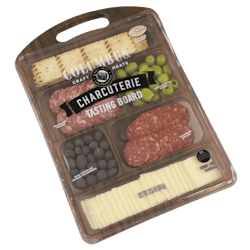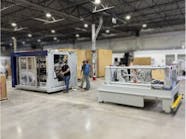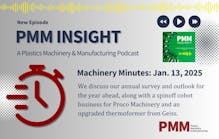By Bruce Geiselman
A shortage of retail labor and a move toward more-sustainable packaging is resulting in an increased demand for thin-wall trays and tubs, said representatives of Amcor, a global company that produces packaging for food, beverage, pharmaceutical, medical, home, personal-care and other products.
Case-ready packaging now accounts for 83 percent of the product in fresh meat cases, up from 49 percent in 2002, an Amcor spokeswoman said, citing statistics from the National Meat Case Study 2022, which was presented at the Annual Meat Conference and sponsored by Cryovac.
“Additionally, tray demand is increasing as labor continues to be a concern for retailers,” Melanie Bandari, senior marketing manager at Amcor, said. “They are utilizing case-ready product more often instead of products being packed at the store. As processors and retailers plan for the move away from EPS [expanded polystyrene foam] trays into more-sustainable options, they are looking to the more-sustainable or recyclable materials of APET [amorphous-polyethylene terephthalate], polypropylene and CPET [crystalline polyethylene terephthalate] for tray packaging.”
All of Amcor’s thermoformed articles, like food trays and tubs, are thin-wall containers, Bandari said.
“We define it as an article with a wall length approximately 200 times longer than its wall thickness (L/T 200),” Bandari said in an email explaining the company’s approach to thin-wall packaging. “The products we are talking about vary in thickness and are oftentimes custom made to a customer-requested specification. When the project calls for reduced plastic, Amcor works with our customers to create the ideal custom product solution.”
In the meat, poultry and seafood space, Amcor has launched several more sustainable options in the past year, Bandari said.
“Curbside recyclable tray options — in communities offering this service — have garnered interest as consumers shift away from EPS trays and PVC overwrap. Amcor offers product solutions in APET, polypropylene, CPET and paperboard.”
Bandari said Amcor’s recent development of a tub for “grab-and-go” food as a success story in thin-wall packaging.
“We developed a 16-ounce clear plastic barrier APET tub with EZ Peel film and lid for use in grab-n-go at retail,” Bandari said. “Grab-n-go is a growing trend for retailers to reduce labor and improve food safety by having product packed off-premise. The products are fresh and appear to be packaged at the store. These tubs feature best-in-class PE lidding film sealant for extended shelf life, high clarity and added freshness.”
Amcor also developed the Columbus Charcuterie Tasting Board, sold by Hormel and containing a variety of sliced meats, cheeses, crackers and other finger foods. It is made from a printed APET structure that comes in a custom tray that mimics the look of wood grain.
“The tray provides consumers with on-the-go convenience, a beautiful presentation and a premium charcuterie experience,” Bandari said. “This product recently was voted Product of the Year Canada.” Consumer research company Kantar conducted a national survey of 4,000 Canadian shoppers to rate winners in 25 categories; the charcuterie board won in the appetizer category.
Amcor is working to increase the amount of recycled content in its packaging.
“Amcor continues to work to incorporate recycled content into product offerings, increasing circularity in the market,” said Matt Peterka, senior director of research and development. “CPET or APET sheet or pre-made trays are perfectly suited for this available offering. Amcor is also partnered with industry leaders to be able to offer ARM (advanced recycled materials) in the barrier sealants associated with Amcor thin-wall products in the market with zero compromises on performance.”
Bruce Geiselman, senior staff reporter
Amcor Flexibles North America, Deerfield, Ill., 224-313-7000, www.amcor.com/afna
Bruce Geiselman | Senior Staff Reporter
Senior Staff Reporter Bruce Geiselman covers extrusion, blow molding, additive manufacturing, automation and end markets including automotive and packaging. He also writes features, including In Other Words and Problem Solved, for Plastics Machinery & Manufacturing, Plastics Recycling and The Journal of Blow Molding. He has extensive experience in daily and magazine journalism.






